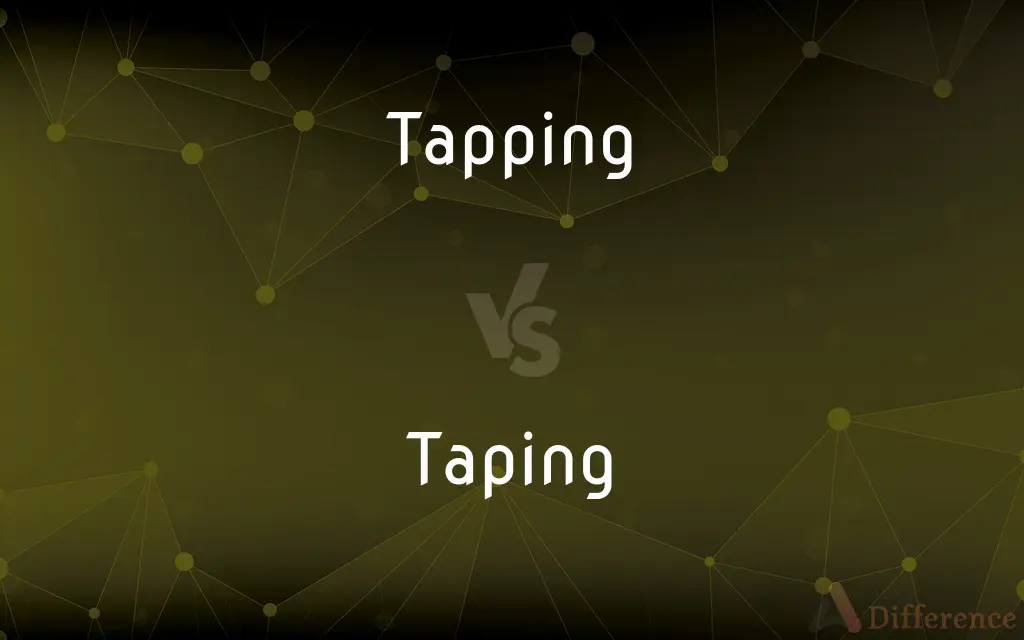Tapping vs. Taping — What's the Difference?
Edited by Tayyaba Rehman — By Urooj Arif — Updated on March 6, 2024
Tapping involves lightly striking or touching, while taping refers to recording or securing with adhesive tape.

Difference Between Tapping and Taping
Table of Contents
ADVERTISEMENT
Key Differences
Tapping is the action of lightly striking or touching something or someone, often with a rhythm or to attract attention. It can be done with fingers, a tool, or any object suitable for the purpose. Tapping is also used in technology, such as tapping on a screen to interact with apps or devices, and in music, where a musician might tap on an instrument to produce sound. On the other hand, taping involves using adhesive tape to attach, secure, or mend something. It can also refer to the process of recording audio or video onto magnetic tape or another recording medium.
While tapping is associated with a gentle, often repetitive action that can convey a range of meanings—from signaling to initiating a command on a touch-sensitive device—taping is a practical activity focused on adhesion or recording. Taping requires materials like adhesive tape or recording equipment, depending on the context. In contrast, tapping can be spontaneous and require no additional tools beyond the body or a simple object.
In the context of smartphones or tablets, tapping is a fundamental interaction method, requiring users to lightly touch the screen to select options, type, or navigate through apps. Conversely, taping in a technological context might involve setting up recording equipment or securing cables and devices with adhesive tape to ensure stability and organization, showing the distinct nature of these actions within technological environments.
Tapping can also be therapeutic, such as in techniques used for stress relief or to improve concentration, where individuals tap on specific body parts following a sequence. Meanwhile, taping is used in medical and sports settings, where physical therapists and trainers apply adhesive tape to the body to support, protect, or compress muscles and joints, indicating the physical and practical application of taping in health and wellness.
In music, tapping is a technique used by musicians, especially guitarists, to produce notes with a direct finger action on the fretboard, creating a distinct sound and style of play. Taping in the music world, however, might refer to the act of recording a performance or session, highlighting the different applications of tapping and taping in artistic expression.
ADVERTISEMENT
Comparison Chart
Definition
Lightly striking or touching.
Attaching with adhesive tape or recording.
Purpose
To attract attention, interact, or produce sound.
To secure, mend, or record audio/video.
Tools Used
Fingers, tools, instruments.
Adhesive tape, recording devices.
Contexts
Technology, music, therapy.
Medical, sports, recording.
Action Nature
Gentle and often repetitive.
Practical and focused on adhesion/recording.
Compare with Definitions
Tapping
Lightly striking a surface.
She kept tapping the desk with her pen.
Taping
Securing with adhesive tape.
Taping the broken frame held it together.
Tapping
Musical technique.
He amazed the audience with his tapping guitar solo.
Taping
Organizing cables.
Taping cables to the floor prevents tripping hazards.
Tapping
Therapeutic method.
Tapping on specific points can reduce stress.
Taping
Recording audio or video.
They were taping the lecture for online students.
Tapping
Signaling method.
Tapping his watch, he signaled it was time to leave.
Taping
Medical application.
Taping the ankle helps prevent further injury.
Tapping
Interacting with touch screens.
Tapping the icon opens the app.
Taping
Sealing packages.
She finished packing by taping the box shut.
Tapping
Tapping, also called tap style (tapstyle), touch-style, and two-handed tapping, is a guitar playing technique where a string is fretted and set into vibration as part of a single motion of being tapped onto the fretboard, with either hand, as opposed to the standard technique of fretting with one hand and picking with the other. Tapping is the primary technique intended for some instruments such as the Chapman Stick, and is the alternative method for the Warr Guitar and others.
Taping
A continuous narrow, flexible strip of cloth, metal, paper, or plastic, such as adhesive tape, magnetic tape, or ticker tape.
Tapping
The action of striking against something with a quick light blow or blows, or a sound made in this way
There was a tapping at the door
Crews heard tapping from deep underground
In the background I could hear a tapping noise
Taping
A narrow strip of strong woven fabric, as that used in sewing or bookbinding.
Tapping
An electrical connection made to some point between the end terminals of a transformer coil or other component.
Taping
A string stretched across the finish line of a racetrack to be broken by the winner.
Tapping
The act of one that taps.
Taping
A length, reel, or cassette of magnetic tape.
Tapping
The process or means by which something is tapped.
Taping
A recording made on magnetic tape.
Tapping
Something that is taken or drawn by tapping.
Taping
A tape measure.
Tapping
An act of making a light hit or strike against something.
Taping
To fasten, secure, strengthen, or wrap with a tape
Taped the box so that it wouldn't fall apart.
Tapping
(music) A guitar technique in which the strings are tapped against the fingerboard
Taping
To record (sounds or pictures) on magnetic tape or other electronic storage medium
The reporter taped the interview.
Tapping
The process by which a resource is tapped or exploited.
Taping
To measure with a tape measure.
Tapping
(electrical engineering) A connection made to some point between the end terminals of a transformer coil or other component.
Taping
To make a recording on magnetic tape or other electronic storage medium.
Tapping
Present participle of tap
Taping
Present participle of tape
Tapping
The sound of light blow or knock;
He heard the tapping of the man's cane
Taping
The act of something being recorded on tape.
When we were in Los Angeles, we went to the taping of the television show The Price is Right.
Taping
The act of something being stuck with adhesive tape.
Taping
A recording made on magnetic tape;
The several recordings were combined on a master tape
Common Curiosities
Is taping always related to adhesive tape?
No, taping can also refer to recording audio or video, besides using adhesive tape for securing items.
Can tapping be used in technology?
Yes, tapping is commonly used to describe interacting with touch-sensitive devices.
Can tapping be considered a musical technique?
Absolutely, tapping is a recognized guitar technique that involves playing notes by tapping the strings directly on the fretboard.
How is taping used in sports?
In sports, taping is used to support and protect muscles or joints, or to secure protective gear.
What is the primary difference between tapping and taping?
Tapping is about lightly striking, while taping focuses on using adhesive tape or recording.
Can tapping be automated in technological applications?
Yes, automated systems can simulate tapping actions for testing touch-sensitive devices.
Is there a learning curve to tapping techniques in music?
Yes, mastering tapping on a musical instrument requires practice and skill development.
Is there a therapeutic use for tapping?
Yes, tapping techniques are used in therapies to help with stress relief, anxiety, and concentration.
What are some common mistakes in taping?
Improper application, using the wrong type of tape, or taping too tightly can be common mistakes.
Can taping be used in artistic contexts?
Yes, it can be used creatively in art installations or to secure backdrops and props.
Is tapping a universal interaction method for all touch screens?
Generally, yes, tapping is a fundamental gesture for interacting with most touch-screen devices.
How do cultural differences influence the use of tapping and taping?
Cultural differences may affect the prevalence and methods of tapping in therapeutic practices and the types of materials and techniques used in taping.
What types of tape are used in taping?
Various types, including adhesive, duct, medical, and athletic tapes, depending on the application.
How does taping benefit physical therapy?
Taping provides support, reduces pain, and stabilizes injured areas during the healing process.
How do professionals choose between tapping and taping in medical contexts?
The choice depends on the objective: tapping for diagnostic or therapeutic techniques, and taping for support and protection.
Share Your Discovery

Previous Comparison
Heptagon vs. Hectagon
Next Comparison
Bridge vs. CausewayAuthor Spotlight
Written by
Urooj ArifUrooj is a skilled content writer at Ask Difference, known for her exceptional ability to simplify complex topics into engaging and informative content. With a passion for research and a flair for clear, concise writing, she consistently delivers articles that resonate with our diverse audience.
Edited by
Tayyaba RehmanTayyaba Rehman is a distinguished writer, currently serving as a primary contributor to askdifference.com. As a researcher in semantics and etymology, Tayyaba's passion for the complexity of languages and their distinctions has found a perfect home on the platform. Tayyaba delves into the intricacies of language, distinguishing between commonly confused words and phrases, thereby providing clarity for readers worldwide.














































